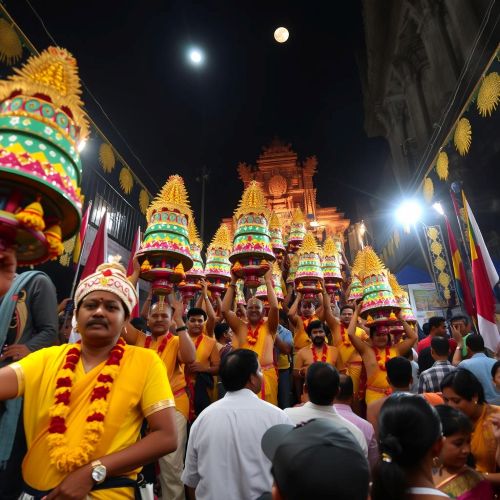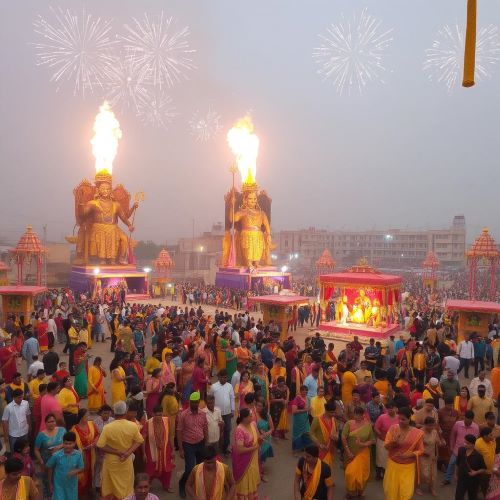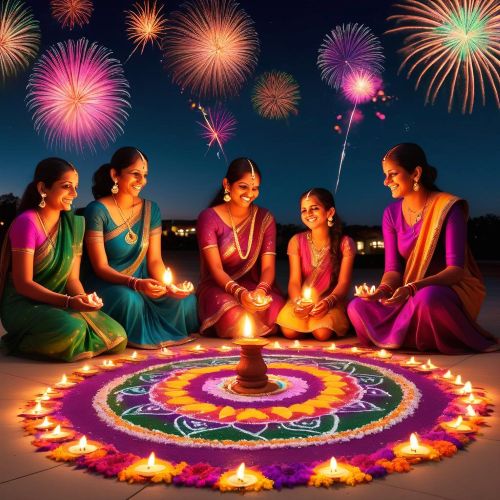
Thaipusam : Celebration of Victory
At a glance
| Description | |
|---|---|
| Location | Tamil Nadu |
| Country | India |
| Dedicated To | Murugan |
| Duration | 1 day |
| Time of Year | February |
Introduction
Thaipusam is more than a festival—it’s a sensory and spiritual journey that grips the hearts of Tamil Hindus around the world. Celebrated on the full moon day in the Tamil month of Thai (January–February), Thaipusam honors Lord Murugan, the deity of youth, valor, and virtue. From the beating drums and swirling incense to the sight of kavadi-bearers in deep trance, it’s an unforgettable spectacle of devotion. While its visual grandeur often makes headlines, the soul of Thaipusam lies in its profound symbolism of sacrifice, inner purification, and the triumph of good over evil.
Connection with Mythology
The mythological essence of Thaipusam is rooted in the epic tale of Lord Murugan’s battle against the demon Surapadman. According to the Kanda Puranam, the asura Surapadman terrorized the heavens after obtaining immense power through penance. In response, Lord Shiva conjured Murugan from divine energy. The child, born of fire and raised by the Kṛttikās (celestial nymphs), was later given the powerful Vel (spear) by his mother Parvati—an emblem of righteousness and divine will.
Armed with this celestial weapon, Murugan destroyed Surapadman in a fierce showdown. As a symbol of transformation, the demon’s split body became a peacock and a rooster, which Murugan adopted as his vehicle and banner. This victory wasn’t just a cosmic war—it was a metaphor for conquering inner darkness. Thaipusam memorializes this event, inviting devotees to confront their personal vices and emerge spiritually renewed.
Main Activities
Thaipusam preparations begin long before the actual day, as devotees embark on a journey of physical restraint and spiritual focus. Fasting, celibacy, and abstention from meat and alcohol help cleanse the body and mind. Many wake early for daily prayers and wear saffron or white clothing as symbols of purity.
The most iconic ritual is the Kavadi Attam, a devotional dance performed while carrying a “kavadi”—a decorated wooden or metal frame that rests on the shoulders. Kavadi bearers often walk barefoot for miles, sometimes under intense heat, as they make their way to Murugan temples. Offerings such as milk (paal kudam), fruits, or flowers are carried, and in extreme acts of devotion, some devotees pierce their tongues, cheeks, or bodies with skewers. Despite the apparent pain, many claim to feel no discomfort, entering trance-like states induced by prayer and ritual chanting.
These acts are deeply personal expressions of gratitude, penance, or a plea for divine intervention. At major sites like the Batu Caves in Malaysia, or the Palani temple in Tamil Nadu, the atmosphere is electric—rhythmic drumming, chants of “Vel Vel Muruga,” and clouds of camphor smoke make it a powerful spiritual experience.
Importance in Cultural History
Historically, Thaipusam has been a unifying force within Tamil communities. Under colonial rule, when indigenous cultural practices were often suppressed or looked down upon, the festival became a beacon of ethnic pride and identity. It reaffirmed the resilience of Tamil traditions and the ability of communities to express faith on their own terms.
At its core, Thaipusam teaches discipline, humility, and the virtue of endurance. The kavadi journey is often compared to the pilgrim’s inner path—shedding ego, pride, and material desires. Over time, it has come to represent not just religious devotion but the very essence of Tamil heritage, especially among diaspora communities seeking to preserve their cultural roots.
Need a place to stay? Book your hotel room now!
International Appeal
Thaipusam’s resonance has crossed oceans, thanks to the vibrant Tamil diaspora. Today, it is celebrated with fervor in countries as diverse as Malaysia, Singapore, Sri Lanka, Mauritius, South Africa, Canada, and the UK. These celebrations have not only kept the faith alive among expatriates but have also introduced the larger global audience to Tamil religious and cultural traditions.
In Malaysia, where Thaipusam is a national event, more than a million people flock to the Batu Caves each year. The sight of thousands of devotees climbing 272 steps, often bearing heavy kavadis or enduring body piercings, is both humbling and awe-inspiring. Singapore’s celebration, particularly the 3.2 km procession between Sri Srinivasa Perumal and Sri Thendayuthapani temples, showcases multicultural harmony and spiritual grandeur.
Even in Western cities like Toronto and London, Thaipusam processions draw large crowds, complete with devotional music, community meals, and religious discourses. These global gatherings reflect how the festival’s themes—overcoming hardship, spiritual transformation, and communal unity—resonate beyond cultural and geographic boundaries.
Source
Audley Travel US. (n.d.). Thaipusam Festival, Malaysia. https://www.audleytravel.com/us/malaysia/places-to-visit/thaipusam-festival
CNN. (2019, January 20). What is Thaipusam? Faith, ritual and wild body piercings. https://edition.cnn.com/travel/article/thaipusam-india-malaysia-singapore/index.html
Duastro. (2025, June 12). Thaipusam: A Colorful Celebration of Faith and Devotion. https://www.duastro.com/blog/thaipusam
France 24. (2025, February 11). Malaysia’s Hindus mark Thaipusam festival with fervour. https://www.france24.com/en/live-news/20250211-malaysia-s-hindus-mark-thaipusam-festival-with-fervour
ISKL. (2025, June 24). Jom Belajar: The Religious Festival – Thaipusam. https://www.iskl.edu.my/news/jom-belajar-thaipusam-festival/
Wikipedia. (2004, February 6). Thaipusam. https://en.wikipedia.org/wiki/Thaipusam
Kanchi Periva Forum. (2014, January 14). THAIPUSAM -the MURUGAN FESTIVAL. https://mahaperiyavaa.wordpress.com/2014/01/14/thaipusam-the-murugan-festival/
Odynovo Tours. (2025, April 22). Thaipusam Festival in Malaysia 2026. https://www.odynovotours.com/malaysia-tours/festival-activities-guide/thaipusam-festival.html
Frequently Asked Questions
Lorem ipsum dolor sit amet, consectetur adipiscing?
Lorem ipsum dolor sit amet, consectetur adipiscing elit. Praesent convallis vestibulum justo, ac tincidunt nunc vehicula quis. Nullam id dolor quis orci malesuada feugiat. Curabitur aliquet libero at urna ullamcorper, ac ultricies nulla dapibus.
Lorem ipsum dolor sit amet, consectetur adipiscing?
Lorem ipsum dolor sit amet, consectetur adipiscing elit. Praesent convallis vestibulum justo, ac tincidunt nunc vehicula quis. Nullam id dolor quis orci malesuada feugiat. Curabitur aliquet libero at urna ullamcorper, ac ultricies nulla dapibus.
Lorem ipsum dolor sit amet, consectetur adipiscing?
Lorem ipsum dolor sit amet, consectetur adipiscing elit. Praesent convallis vestibulum justo, ac tincidunt nunc vehicula quis. Nullam id dolor quis orci malesuada feugiat. Curabitur aliquet libero at urna ullamcorper, ac ultricies nulla dapibus.
Lorem ipsum dolor sit amet, consectetur adipiscing?
Lorem ipsum dolor sit amet, consectetur adipiscing elit. Praesent convallis vestibulum justo, ac tincidunt nunc vehicula quis. Nullam id dolor quis orci malesuada feugiat. Curabitur aliquet libero at urna ullamcorper, ac ultricies nulla dapibus.
Lorem ipsum dolor sit amet, consectetur adipiscing?
Lorem ipsum dolor sit amet, consectetur adipiscing elit. Praesent convallis vestibulum justo, ac tincidunt nunc vehicula quis. Nullam id dolor quis orci malesuada feugiat. Curabitur aliquet libero at urna ullamcorper, ac ultricies nulla dapibus.








